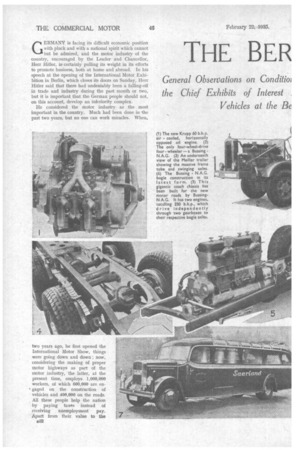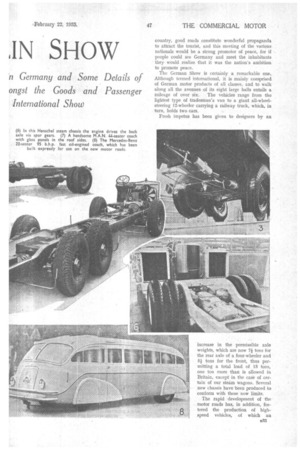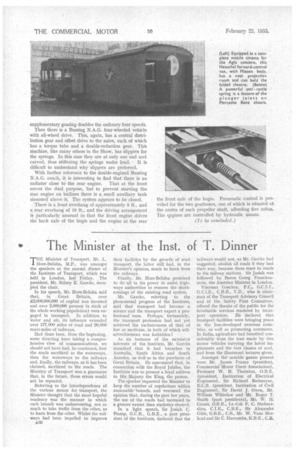THE BER .IN SHOW
Page 50

Page 51

Page 52

Page 53

Page 54

If you've noticed an error in this article please click here to report it so we can fix it.
General Observations on Conditiol the Chief Exhibits of Interest . 'n Germany and Some Details of ongst the Goods and Passenger International Show Vehicles at the Be
GERMANY is facing its difficult economic position with pluck and with a national spirit which cannot , but be admired, and the motor industry of the country, encouraged by the Leader and Chancellor, Herr Hitler, is certainly pulling its weight in its efforts to promote business, both at home and abroad. In his speech at the opening of the International Motor Exhibition in Berlin, which closes its doors on Sunday, Herr Hitler said that there had undeniably been a falling-off in trade and industry during the past month or two, but it is important that the German people should not, on this account, develop an inferiority complex.
He considered the motor industry as the most important in the country. Much had been done in the past two years, but no one can work miracles. When,
two years ago, he first opened the International Motor Show, things were going down and down ; now, considering the making of proper motor highways as part of the motor industry, the latter, at the present time, employs 1,000,000 workers, of which 600,000 are en, gaged on the construction of vehicles and 400,000 on the roads. All these people help the nation by paying taxes instead of receiving unemployment pay. Apart from their value to the country, good roads constitute wonderful propaganda to attract the tourist, and this meeting of the various nationals would be a strong promoter of peace, for if people could See Germany and meet the inhabitants they would realize that it was the nation's ambition to promote peace.
The German Show is certainly a remarkable one. Although termed international, it is mainly comprised of German motor products of all classes, and to walk along all the avenues of its eight large halls entails a mileage of over six. The vehicles range from the lightest type of tradesman's van to a giant all-wheelsteering 12-wheeler carrying a railway track, which, in turn, holds two cars.
Fresh impetus has been given to designers by an
increase in the permissible axle weights, which are now 7i tons for the rear axle of a four-wheeler and Sitons for the front, thus permitting a total load of 13 tons, one ton more than is allowed in Britain, except in the case of certain of our steam wagons. Several new chassis have been produced to conform with these new limits.
The rapid development of the motor roads has, in addition, fostered the production of highspeed vehicles, of which an
outstanding example is . the Bussing N.A.G., which has an engine at each end giving a total output of 280 b.h.p. and a speed of 120 k.p.h., or, approximately, 75 m.p.h. We will refer to this vehicle in greater detail later. Another fine example of the highspeed coach for these roads is the Mercedes-Benz 22-seater with a 95 b.h.p. engine, the striking lines of which can be seen in one of the illustrations accompanying this article.
There is no diminution in interest in respect of the oil engine, but a noticeable increase in the development of engines which can consume fuels other than petrol.
Many vehicles are shown equipped with gas producers. In one Henschel lorry two of Deutz make are neatly accommodated, and almost concealed, at the sides of the vehicle behind the cab. Buses are on view with producers mounted within the bodywork at the rear, and one machine, a Faun, has the Deutz producer working in conjunction with what was originally an oil engine, suitably modified by employing a special head with sparking plugs and magneto ignition. The compression is 10 to 1, and it is claimed that the loss of efficiency, compared with liquid fuel, is only 10-12 per cent. What is more, the head can easily be lifted and replaced by a type suitable for compression ignition, using a Bosch fuel pump. This vehicle, which is a heavy model, recently ran 460 idioms., in 121 hours, entirely on wood fuel.
Some Compressed-gas Vehicles.
Incidentally, another Faun is shown with methanegas cylinders, the petrol carburetter being retained for emergency purposes. This model is a street-washing machine and emergency fire tender, and it has two 5-ft. cylinders along the sides, giving it a range of 100 kiloms.
A new fuel has been brought out by a company
hitherto distilling benzole and is known as RohrgasoI. It is a secret product and, at present, is only under test, but its main property is that, whilst being rapidly liquefiable, so that a large quantity cart be stored in a couple of cylinders, yet at ordinary temperature and pressure it becomes a gas. The two cylinders, on a large vehicle, give a range of 200 kiloms.
An Air-cooled Oil Engine.
One Magirus model, with a six-cylindered engine and two carburetters, is equipped with three large coal-gas cylinders with suitable reducing valves. A noticeable feature is that the gas-air mixture is water-heated in a casing carried above the cylinder bead and connected to the radiator. We also noted one Ford private car, in which an Imbert producer was cleverly concealed in a boot at the back. Amongst the new oil engines is a 60 b.h.p. air-cooled Krupp of the type with four horizontally opposed .cylinders. This has been built in response to a demand for a rather more powerful engine than the 50 b.h.p. model, and beyond the fact that the dynamo is now driven by a belt instead of oil the front of the crankshaft, it closely resembles its prototype. Twenty Krupp lorries with the smaller engine, and some small buses are zunning in Holland, and what is perhaps, more interesting—because these engines are air cooled—others are in operation in the Dutch East Indies,
One type of M.A.N. oil engine won first prize in the recent Russian Reliability Trials. A large number of models is on view. They are of exceptionally clean design. TheHenschel Lanova is another unit most commendable in this respect. This type is known to give a low maximum pressure without loss of efficiency, thus greatly relieving the loading stresses on the bearings.
Many Types of Battery-electric Vehicle on View. • In view of the efforts being made in England to develop the battery-electric vehicle, the fact that there is quite a number of makes in Germany is of interest. In the Hague alone there are 100 electric dust carts of Faun 'manufacture, in which the two driving motors are incorporated in the wheels.
The Hansa-Lloyd electric has the controller mounted _ under a bonnet resembling that of a petrol vehicle, a.
false radiator adding to the illusion. There is one motor at the back, which is bolted direct to the axle at one end and slung from a cross member at the other. This appearance of a petrol vehicle is also followed on the Siemens 2-tonner, which has the controller carried in. the dash, and two spare wheels and tyres under the bonnet.
In the Bergmann the battery is under the bonnet and the controller under the driver's seat. This type is used = by the postal authorities and runs approximately 63 kiloms. per charge. A similar arrangement is adopted in the A.E.G. vehicle. Trolleybuses are represented by a large A.E.G. model with a steel-panelled body, and a Siemens and 11/4,I.A.N. six-wheeler of all-steel construction to carry. 36 people sitting and 30 standing, The A.E.G. concern stages an oil-electric bus with a Bussing N.A.G. engine.
Amongst the larger products is what may be termed
railless train, which has resulted from the inventive genius of Mr. H. W. jonkhoff, and is built by Waggon-Fabrik A.G., Uerdingen. It has a 300 b,h.p. Mercedes-Benz engine of the same type as is used on the oil-electric railcars. Great improvements have been made in the jonkhoff system since we first described it in 1932. Complications have been eliminated and there is now only one steering cross-bar between each pair of wheals. There is a six-wheeler motive unit and three eight-wheeled bogie trailers. The system can now be applied to four wheels mounted in a row. Models enable convincing demonstrations of the value of the system to be given.
Details of a Six-wheel-drive Chassis, In England the rigid six-wheeler has lost much of its popularity in the lighter sizes, and no more are to be subsidized by the War Department after July 81; but in Germany no diminution is observable; in fact, the tendency is in the other direction. There is even a new Mercedes-Benz all-wheel-drive six-wheeler. In this model the drive is taken to a distributor gear and differential, then by shafts forward and backward to differentials slung on the frame, whence cardan shafts take it to the wheels. The front wheels are mounted on what are known in Germany as swinging axles, each supported by a, powerfulcoil spring. In this vehicle the familiar Mercedes-Benz spur reduction gearing within the wheel hubs is retained. Braking is effected through a Bosch Dewandre servo.
The rear bogie arrangement is rather unusual, because the large single rear springs, which are centrally pivoted, are concealed in short casings hinged to the spring brackets'. A narrow frame prevents weaving, and the
supplementary gearing doubles the ordinary four speeds.
Then there is a Bussing N.A.G. four-wheeled vehicle with all-wheel drive. This, again, has a central distribution gear and offset drive to the axles, each of which has a torque tube and a double-reduction gear. This machine, like many others in the Show, has slippers for the springs: In this case they are at only one end and
curved, thus stiffening the springs under load. It is difficult to understand why slippers are preferred.
With further reference to the double-engined Bussing N.A.G. coach, it is interesting to find that there is no radiator close to the rear engine. That at the front serves the dual purpose, but to prevent starving the rear engine on inclines there is a small auxiliary tank Mounted above it. The system appears to be closed.
There is a front overhang of approximately 9 ft., and a rear overhang of 10 ft., and the driving arrangement is particularly unusual in that the front engine drives the back axle of the bogie and the engine at the rear




































































































